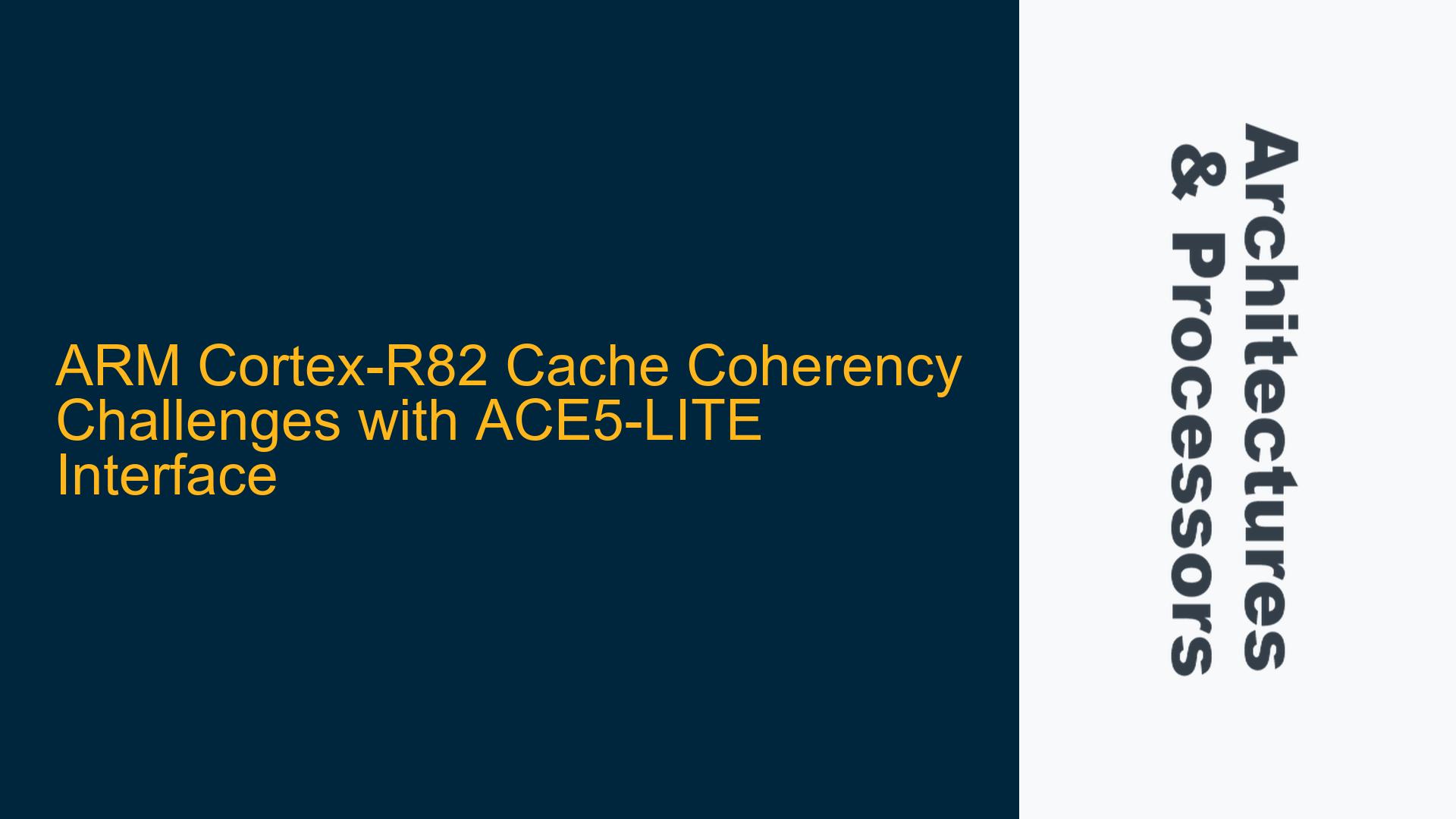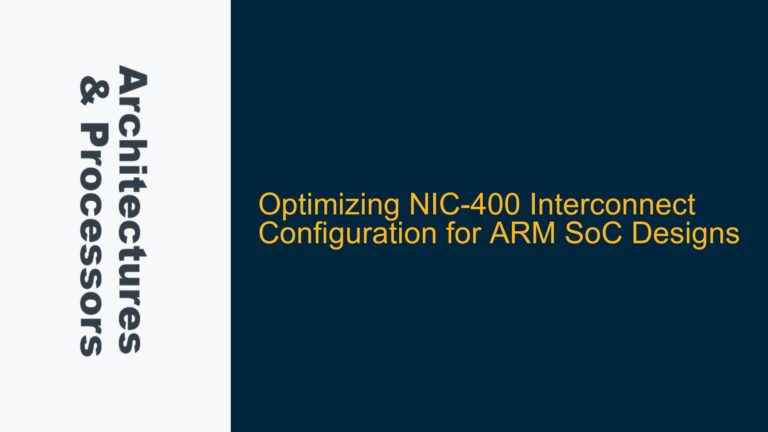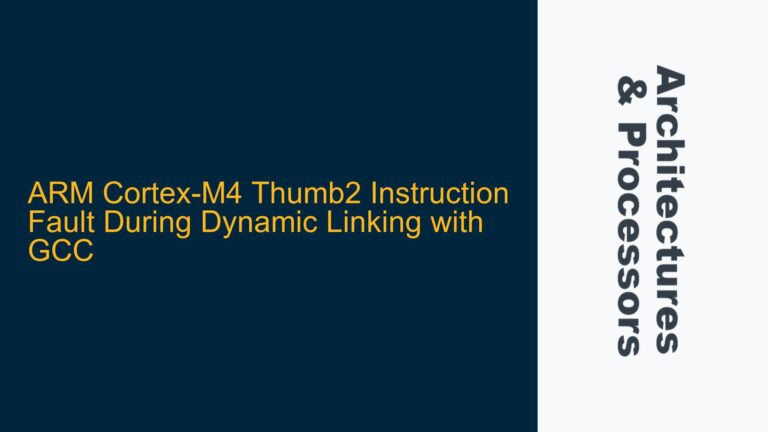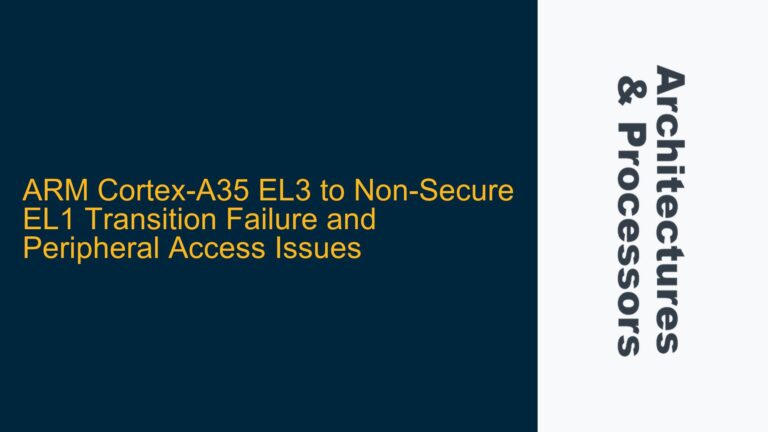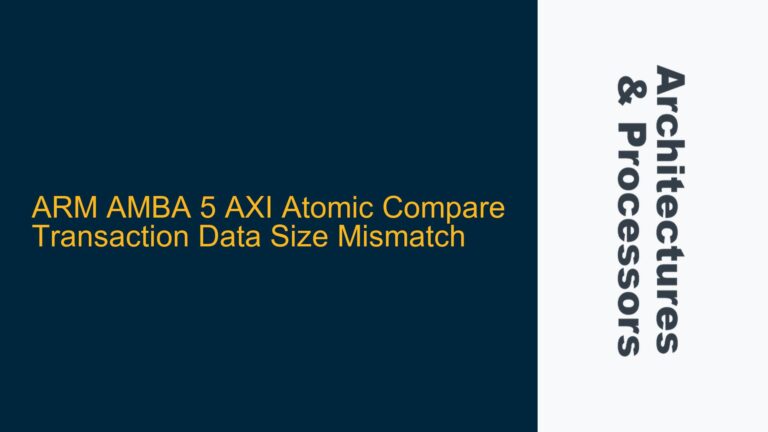ARM Cortex-R82 Cache Coherency in Multi-CPU Systems with ACE5-LITE
The ARM Cortex-R82 processor, equipped with an ACE5-LITE interface, is designed for high-performance real-time applications. However, maintaining cache coherency in systems where the Cortex-R82 interacts with multiple CPUs or hardware modules can present significant challenges. The ACE5-LITE interface, while providing some level of coherency support, does not offer full cache coherency across all system components. This limitation necessitates careful system design and software intervention to ensure data consistency.
When the Cortex-R82 operates alongside other CPUs that have their own caches, the system must ensure that all processors have a consistent view of shared memory. This is particularly critical in multi-core systems where data sharing is frequent. The ACE5-LITE interface supports coherency within its domain but does not automatically extend this coherency to other CPUs or hardware modules that may be accessing the same memory regions. This can lead to scenarios where one CPU updates a memory location, but other CPUs or modules continue to work with stale data, resulting in undefined behavior or system crashes.
In systems where the Cortex-R82 interacts with hardware modules that lack caches, the coherency problem is somewhat different but equally critical. These modules typically access memory directly, bypassing any cache mechanisms. If the Cortex-R82 has cached data that is also being modified by these hardware modules, the processor may not be aware of these changes, leading to inconsistencies. The ACE5-LITE interface does not inherently manage coherency with such non-cached entities, requiring explicit software mechanisms to ensure data integrity.
Memory Barrier Omission and Cache Invalidation Timing
One of the primary causes of cache coherency issues in systems involving the ARM Cortex-R82 and other CPUs or hardware modules is the omission of memory barriers and improper cache invalidation timing. Memory barriers are crucial in ensuring that memory operations are performed in the correct order, especially in multi-core systems where different processors may be accessing shared memory concurrently. Without appropriate memory barriers, there is no guarantee that a write operation performed by one CPU will be visible to another CPU in the expected order, leading to potential data corruption.
Cache invalidation timing is another critical factor. In systems where the Cortex-R82 shares memory with other CPUs or hardware modules, it is essential to invalidate the cache at the right time to ensure that the processor fetches the most recent data from memory. If cache invalidation is performed too early or too late, the Cortex-R82 may end up working with outdated data, leading to incorrect results. This is particularly problematic in real-time systems where timing is critical, and even small delays can have significant consequences.
The ACE5-LITE interface provides some support for cache coherency, but it is not foolproof. It relies on the system designer to implement appropriate memory barriers and cache management strategies. In multi-CPU systems, the lack of a fully coherent interconnect means that the Cortex-R82 and other CPUs must coordinate their cache management activities explicitly. This coordination can be challenging, especially in systems with complex memory access patterns or where multiple CPUs are accessing the same memory regions simultaneously.
In systems where the Cortex-R82 interacts with hardware modules that lack caches, the coherency problem is exacerbated. These modules do not participate in the cache coherency protocol, meaning that any changes they make to memory are not automatically reflected in the Cortex-R82’s cache. This requires the Cortex-R82 to explicitly invalidate or flush its cache whenever it accesses memory regions that may have been modified by these hardware modules. Failure to do so can result in the Cortex-R82 working with stale data, leading to incorrect behavior.
Implementing Data Synchronization Barriers and Cache Management
To address the cache coherency challenges in systems involving the ARM Cortex-R82 and other CPUs or hardware modules, it is essential to implement robust data synchronization barriers and cache management strategies. These strategies should be tailored to the specific requirements of the system, taking into account the memory access patterns, the number of CPUs, and the presence of hardware modules that lack caches.
Data Synchronization Barriers
Data synchronization barriers (DSBs) and data memory barriers (DMBs) are critical tools in ensuring that memory operations are performed in the correct order. In multi-CPU systems, DSBs and DMBs should be used to ensure that all CPUs have a consistent view of shared memory. For example, when one CPU updates a shared memory location, it should issue a DSB to ensure that the update is visible to other CPUs before they access the same location. Similarly, DMBs can be used to enforce ordering constraints on memory operations, ensuring that reads and writes are performed in the expected sequence.
In systems where the Cortex-R82 interacts with hardware modules that lack caches, DSBs and DMBs are equally important. These barriers ensure that the Cortex-R82’s cache is properly synchronized with memory, preventing the processor from working with stale data. For example, before the Cortex-R82 accesses a memory region that may have been modified by a hardware module, it should issue a DSB to ensure that any pending writes to that region are completed. This ensures that the Cortex-R82 fetches the most recent data from memory, rather than relying on potentially outdated data in its cache.
Cache Invalidation and Flushing
Cache invalidation and flushing are essential techniques for maintaining cache coherency in systems involving the ARM Cortex-R82 and other CPUs or hardware modules. In multi-CPU systems, cache invalidation should be performed whenever a CPU modifies a shared memory location, ensuring that other CPUs do not work with stale data. The Cortex-R82’s cache can be invalidated using the DC IVAC (Data Cache Invalidate by Virtual Address to PoC) instruction, which invalidates a specific cache line. This instruction should be used in conjunction with memory barriers to ensure that the invalidation is performed at the correct time.
In systems where the Cortex-R82 interacts with hardware modules that lack caches, cache invalidation is even more critical. The Cortex-R82 must invalidate its cache whenever it accesses memory regions that may have been modified by these hardware modules. This ensures that the processor fetches the most recent data from memory, rather than relying on potentially outdated data in its cache. The DC IVAC instruction can be used for this purpose, but care must be taken to ensure that the invalidation is performed at the right time, typically after the hardware module has completed its memory access.
Cache flushing is another important technique, particularly in systems where the Cortex-R82 modifies memory that is shared with hardware modules. Flushing the cache ensures that any modified data is written back to memory, making it visible to other system components. The Cortex-R82’s cache can be flushed using the DC CVAC (Data Cache Clean by Virtual Address to PoC) instruction, which cleans a specific cache line, writing any modified data back to memory. This instruction should be used in conjunction with memory barriers to ensure that the flush is performed at the correct time.
Software-Managed Coherency
In systems where the ACE5-LITE interface does not provide sufficient coherency support, software-managed coherency may be necessary. This involves implementing explicit software mechanisms to ensure that all system components have a consistent view of shared memory. For example, in multi-CPU systems, software-managed coherency may involve using shared memory regions as communication buffers, with each CPU explicitly invalidating or flushing its cache when accessing these regions. This approach requires careful coordination between CPUs, but it can be effective in ensuring data consistency.
In systems where the Cortex-R82 interacts with hardware modules that lack caches, software-managed coherency is often the only option. The Cortex-R82 must explicitly invalidate or flush its cache whenever it accesses memory regions that may have been modified by these hardware modules. This can be achieved using the cache management instructions discussed earlier, but it requires careful attention to timing and synchronization. In some cases, it may be necessary to implement additional software mechanisms, such as flags or semaphores, to coordinate access to shared memory regions.
Performance Considerations
While implementing data synchronization barriers and cache management strategies is essential for maintaining cache coherency, it is also important to consider the performance implications of these techniques. Excessive use of memory barriers, cache invalidation, and flushing can introduce significant overhead, potentially impacting the overall performance of the system. Therefore, it is important to strike a balance between ensuring data consistency and minimizing performance degradation.
One approach to minimizing performance impact is to optimize the use of memory barriers and cache management instructions. For example, instead of issuing a DSB after every memory operation, it may be possible to group related operations and issue a single DSB at the end of the group. Similarly, cache invalidation and flushing can be optimized by invalidating or flushing only the specific cache lines that are affected by a memory operation, rather than invalidating or flushing the entire cache.
Another approach is to use hardware features, such as the Cortex-R82’s cache locking mechanism, to improve performance. Cache locking allows specific cache lines to be locked in the cache, preventing them from being evicted. This can be useful in real-time systems where certain memory regions are accessed frequently and must be available with low latency. By locking these regions in the cache, the Cortex-R82 can avoid the overhead of repeatedly fetching them from memory, improving overall system performance.
Conclusion
Maintaining cache coherency in systems involving the ARM Cortex-R82 and other CPUs or hardware modules is a complex but essential task. The ACE5-LITE interface provides some level of coherency support, but it is not sufficient on its own. System designers must implement robust data synchronization barriers and cache management strategies to ensure data consistency. This involves using memory barriers, cache invalidation, and flushing techniques, as well as potentially implementing software-managed coherency mechanisms. While these techniques can introduce performance overhead, careful optimization can help minimize their impact, ensuring that the system operates efficiently while maintaining data integrity.
